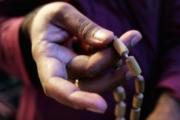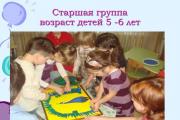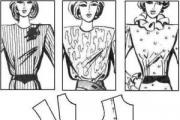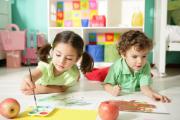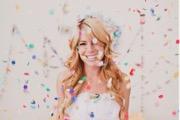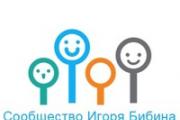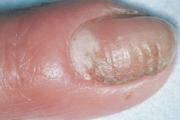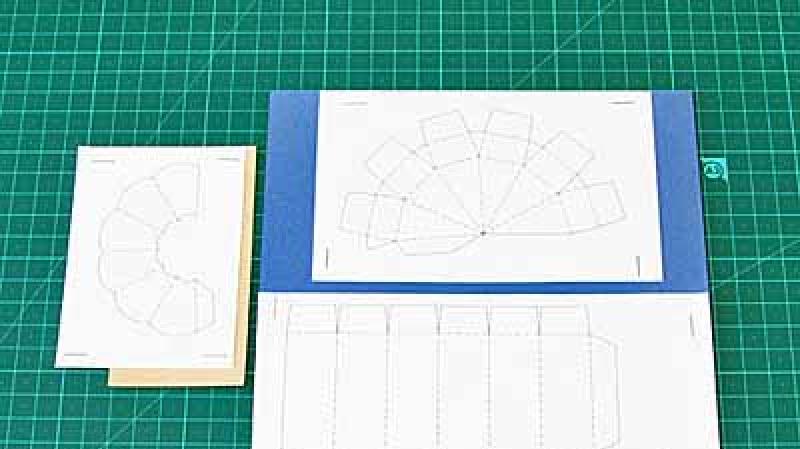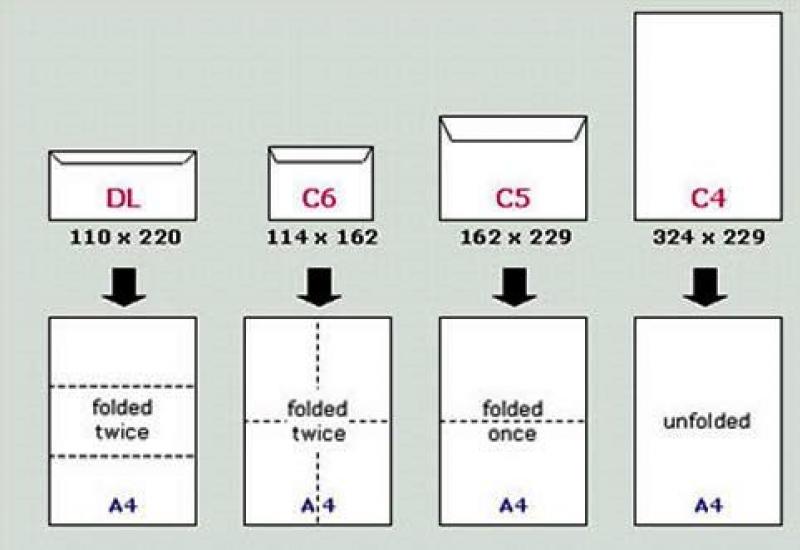Presentation on the topic: “My family” presentation for a lesson (middle group) on the topic. Presentation for preschoolers "May 15 - International Family Day" Children are not judges of parents

Relevance of the project Raising children, shaping the personality of a child from the first years of his life is the main responsibility of parents. The family influences the child and introduces him to the life around him. We, adults, must help children understand the importance of family, cultivate in children love and respect for family members, and instill in children a sense of attachment to family and home.




Project content: Creative story on the theme “My loved ones”, “We are different”, “About my beloved dad”, “Day off in my family” Finger gymnastics “Finger is a boy”, “My family” Children’s drawings on family themes, didactic games, photographs of leisure activities Exhibition “Mom’s hands - never get bored”, Wall newspaper “Our Family”, Photo album “Me and My Family” Musical leisure “My mother is the best” dedicated to Mother’s Day on November 25.

Project product: Systematization of children's knowledge about their family, the life of the older generation, and the profession of their parents. Photo newspaper “Me and My Family”, photo album “Our Family”, children’s drawings on the topic “Family Portrait”, compiling a family pedigree together with the parents.



Stages of work on the project: Stages Forms of work with parents Forms of work with children Joint activities of children and adults 1 Conversation with parents “Parent sounds proud” Conversations: “We are different”, “My family”, Looking at photographs of family members with children; Finger gymnastics: “Our Family”, “Finger Boy” Dramatization games “Turnip”, “Little Red Riding Hood” Competition “Favorite Family Dish” 2 Questionnaire “Family through the eyes of children and their parents” S/r game “Family”, “Clothing Salon” ", "Daughters - Mothers" Dramatization games "Turnip", "Little Red Riding Hood" Thematic lesson "Who do I live with" Publication of the family newspaper "My Family" Design of the family tree "My Pedigree". 3 Consultation “The role of mother and father in the development of the child” Reading fiction on the topic “Family” Drawing on a family theme GCD from the series “My Mom”, “Family Budget”... Competition “Mom, Dad, I - a sports family” 4 exhibition: “ Mom’s hands – never get bored” family tree “My Family Tree”. Album design: “My Family.” Joint participation of parents in leisure time: “My mother is the best” Album design: “My family.”



List of used literature: Project method in the activities of preschool educational institutions. Moscow, 2006 Osipova L.E., Work of preschool educational institutions with families, 2008 Danilina T.A., Interaction of preschool educational institutions with society. – M.: ARKTI, 2004 Ryleeva E. Practical encyclopedia of family education. – M.: AKALIS, 1998 Internet resources


Slide 1
Municipal budgetary preschool educational institution kindergarten No. 15 “Kolosok” village. Rozhdestveno Project: “I’ll tell all the kids about my family.”Slide 2
 Business card of the MBDOU Name of the preschool educational institution Municipal budgetary preschool educational institution - kindergarten No. 15 “Spikelet” of a general developmental type in the village of Rozhdestveno. Address 601232 Vladimir region, Sobinsky district, village. Rozhdestveno, st. Poroshina, house 12. General education program implemented at the preschool educational institution “From birth to school” N.E. Veraksy, T.S. Komarova, M.A. Vasilyeva. Number of pupils: 49 children, 3 general developmental groups.
Business card of the MBDOU Name of the preschool educational institution Municipal budgetary preschool educational institution - kindergarten No. 15 “Spikelet” of a general developmental type in the village of Rozhdestveno. Address 601232 Vladimir region, Sobinsky district, village. Rozhdestveno, st. Poroshina, house 12. General education program implemented at the preschool educational institution “From birth to school” N.E. Veraksy, T.S. Komarova, M.A. Vasilyeva. Number of pupils: 49 children, 3 general developmental groups.
Slide 3
 Author of the project: Alla Petrovna Povago – teacher of the first qualification category, 11 years of work experience.
Author of the project: Alla Petrovna Povago – teacher of the first qualification category, 11 years of work experience.
Slide 4
 Duration of the project: March 17 - March 21 Project participants: Children of the 2nd junior - middle group. Families of pupils Teacher
Duration of the project: March 17 - March 21 Project participants: Children of the 2nd junior - middle group. Families of pupils Teacher
Slide 5
 Relevance The content of moral education of preschoolers includes solving many problems, including instilling love for the Motherland, family, and respect for one’s parents. Few children know their family history or their ancestry. Family holidays and traditions are becoming a thing of the past. In order to study the family, establish contact with its members, and coordinate educational influences on the child, the idea came up to create the project “I’ll tell all the kids about my family,” which helps children understand the importance of family, instill in children love and respect for its members, and instill a sense of affection. to family and home.
Relevance The content of moral education of preschoolers includes solving many problems, including instilling love for the Motherland, family, and respect for one’s parents. Few children know their family history or their ancestry. Family holidays and traditions are becoming a thing of the past. In order to study the family, establish contact with its members, and coordinate educational influences on the child, the idea came up to create the project “I’ll tell all the kids about my family,” which helps children understand the importance of family, instill in children love and respect for its members, and instill a sense of affection. to family and home.
Slide 6
 Goal: To develop in children a sense of family cohesion, to cultivate interest in the history of their family. To develop communication, cooperation, and co-creation skills between parents and children. Strengthen family values and traditions.
Goal: To develop in children a sense of family cohesion, to cultivate interest in the history of their family. To develop communication, cooperation, and co-creation skills between parents and children. Strengthen family values and traditions.
Slide 7
 Objectives: To instill in children love and respect for family members, to show the value of family for every person and to show care for loved ones. Develop the creative abilities of parents and children in the process of joint activities. To form in children an idea of the family, of a moral attitude towards family traditions, to expand knowledge about their immediate environment, to teach them to understand family ties.
Objectives: To instill in children love and respect for family members, to show the value of family for every person and to show care for loved ones. Develop the creative abilities of parents and children in the process of joint activities. To form in children an idea of the family, of a moral attitude towards family traditions, to expand knowledge about their immediate environment, to teach them to understand family ties.
Slide 8
 Expected result: Children will learn more about their family: family members, traditions, and the life of their grandparents. Joint activities will help strengthen child-parent relationships. Fostering a sense of pride in your family and love for its members.
Expected result: Children will learn more about their family: family members, traditions, and the life of their grandparents. Joint activities will help strengthen child-parent relationships. Fostering a sense of pride in your family and love for its members.
Slide 9
 How the project began: The teacher brought a photo album with photographs of her family to the group. The children became interested and began to talk about their families. This is how the project “I’ll tell all the kids about my family” began.
How the project began: The teacher brought a photo album with photographs of her family to the group. The children became interested and began to talk about their families. This is how the project “I’ll tell all the kids about my family” began.
Slide 10
 Information about the project: Preparatory stage: collection of information, preparation of equipment. Main stage: working with children: organizing joint activities with children, conducting educational classes on relevant topics. work with parents: designing information stands on a specific topic, organizing joint parent-child activities to create an exhibition in a group. equipping the subject-development environment: organizing groups in accordance with the theme, organizing a joint exhibition. Final stage: holding an exhibition.
Information about the project: Preparatory stage: collection of information, preparation of equipment. Main stage: working with children: organizing joint activities with children, conducting educational classes on relevant topics. work with parents: designing information stands on a specific topic, organizing joint parent-child activities to create an exhibition in a group. equipping the subject-development environment: organizing groups in accordance with the theme, organizing a joint exhibition. Final stage: holding an exhibition.
Slide 11
 Project implementation: Direct educational activities for children. Independent activity of children. Educational activities during regime moments. Interaction with family. The result of the project.
Project implementation: Direct educational activities for children. Independent activity of children. Educational activities during regime moments. Interaction with family. The result of the project.
Slide 12
 Stages of work on the project: Preparatory: Drawing up a project implementation plan; Studying methodological literature on the topic of the project.
Stages of work on the project: Preparatory: Drawing up a project implementation plan; Studying methodological literature on the topic of the project.
Slide 13
 Stages of work on the project: Basic: Consider photographs of one person taken in different years. Now he is a grandfather. Which photo was taken earlier than the others? Creating a family album for kindergarten. Write a story about yourself according to plan. Drawings with children: “My family”, “The house where I live”. Didactic game: “Who is older?” Design an exhibition of drawings “My Family” Conversations: “What we are like”, “We are different”, “My family” Activities from the series “Me and My Family” Reading fiction, looking at illustrations Learning songs, poems, on family topics Application: “My family" . Video interviews of children about their families in the stories “Family through the eyes of a child.
Stages of work on the project: Basic: Consider photographs of one person taken in different years. Now he is a grandfather. Which photo was taken earlier than the others? Creating a family album for kindergarten. Write a story about yourself according to plan. Drawings with children: “My family”, “The house where I live”. Didactic game: “Who is older?” Design an exhibition of drawings “My Family” Conversations: “What we are like”, “We are different”, “My family” Activities from the series “Me and My Family” Reading fiction, looking at illustrations Learning songs, poems, on family topics Application: “My family" . Video interviews of children about their families in the stories “Family through the eyes of a child.
Slide 14

Slide 15
 Accumulated material: GCD notes (on the project topic). A selection of fiction (on the topic). Album "My Family". Collection "Genealogical Family Tree".
Accumulated material: GCD notes (on the project topic). A selection of fiction (on the topic). Album "My Family". Collection "Genealogical Family Tree".
Slide 16
 Project result: Children learned more about their family: about family members, traditions, about the life of their grandparents. Joint activities contributed to strengthening child-parent relationships.
Project result: Children learned more about their family: about family members, traditions, about the life of their grandparents. Joint activities contributed to strengthening child-parent relationships.
Slide 17
 References: Veraksy N.E., Komarova E.S., Vasilyeva M.A. “Comprehensive Lessons” Edition 2012. Zelenova N.G., Osipova L.E. “We live in Russia” Moscow 2008. Pilipenko L.V. “Practical material for organizing the pedagogical process in preschool educational institutions” Moscow 2007. Zyabkina V.V. , Lgovskaya N.I., Miklyakova N.V. “Moral and aesthetic education in kindergarten and school” Moscow 2012. Danilina T.A. “Interaction of preschool educational institutions with society” Moscow 2004. Kozlova A.V., Deshulina R.P. “Working with the family” Sfera, 2004. “Project method in the activities of preschool educational institutions” Moscow, 2006. Kravtsova E.E. “Awaken the wizard in your child” Enlightenment 1998.
References: Veraksy N.E., Komarova E.S., Vasilyeva M.A. “Comprehensive Lessons” Edition 2012. Zelenova N.G., Osipova L.E. “We live in Russia” Moscow 2008. Pilipenko L.V. “Practical material for organizing the pedagogical process in preschool educational institutions” Moscow 2007. Zyabkina V.V. , Lgovskaya N.I., Miklyakova N.V. “Moral and aesthetic education in kindergarten and school” Moscow 2012. Danilina T.A. “Interaction of preschool educational institutions with society” Moscow 2004. Kozlova A.V., Deshulina R.P. “Working with the family” Sfera, 2004. “Project method in the activities of preschool educational institutions” Moscow, 2006. Kravtsova E.E. “Awaken the wizard in your child” Enlightenment 1998.
Slide 18

Slide 19

Slide 20

Slide 21

Slide 22

To use presentation previews, create a Google account and log in to it: https://accounts.google.com
Slide captions:
“MY FAMILY” The presentation was prepared by the teacher of the GBDOU TsRR d/s No. 89, Krasnogvardeisky district Tverdokhleb Yulia Valerievna
Family Family is happiness, love and luck, Family is a summer trip to the country. Family is a holiday, family dates, gifts, shopping, pleasant spending. The birth of children, the first step, the first babble, Dreams of good things, excitement and trepidation. Family is work, taking care of each other, Family is a lot of homework. Family is important! Family is difficult! But it is impossible to live happily alone! Always be together, take care of love, drive away grievances and quarrels, I want our friends to say about us: How good your family is!
Family harmony is the most valuable thing. A family that helps each other is not afraid of troubles. To cherish your family is to be happy. Family gives a person a start in life. A family is strong when there is only one roof over it. A mother's heart warms better than the sun. Harmony in the family is wealth. A family is strong when there is only one roof over it. A good family will add intelligence and intelligence. There is not much calculation in your family. The whole family is together, and the soul is in place. In your own family the porridge is thicker. Food tastes better at a shared family table. A quarrel in your family - before the first glance. Proverbs about family
The whole family is together, and the soul is in place.
Family is a holiday, family dates
FAMILY IN ANIMALS
Do adults and children know what is most important in the world for cheerful children? Grandmother and mother, Grandfather and father, Brother, sister, of course, me - Together we are.....family!!!
On the topic: methodological developments, presentations and notes
I propose to use the presentation for teachers to demonstrate at a parent meeting, replacing slides with photos of children...
A selection of games on the topic
"My family"
Completed by: teachers
Tkachenkova T.N.
Khodakova I.A.
Senior teacher
Bokhan L.V.

Didactic game “Who’s in charge?”
Goal: teach children to name their family members; bring to the understanding that both children and adults are the most important in the world; cultivate love and respect for your family.
Material: "Family Tree"; illustrations depicting what mom, dad, grandma, grandpa, and child are doing.
The teacher invites the children to take turns naming members of their family and saying: who does what, who does what in the family. If it is difficult for a child to name who does what in the family, then illustrations will help him with this. Children say who is the boss in the family and why they think so. At the end of the game, it should be determined that everyone is important in the world - both children and adults.

Didactic game “What are the names of family members.”
Goal: to strengthen children’s ability to clearly name their family members; develop memory, coherent speech; cultivate love for your family.
Children stand in a circle and take turns naming their family members. For example: “I live with my mother Natasha, father Sasha, brother Vladik. I have grandmother Lida, grandmother Vera, grandfather Grisha and grandfather Pavel.”

"Little Helpers"
Goal: to bring children to the understanding that they need to help their loved ones and give them their love; teach children to talk about their help in their family; develop coherent speech and thinking.
Material: box, bear.
“An upset bear came to the children.” He “quarreled with his mother” because he “didn’t want to put his toys away.” And now he doesn’t know how to make peace with his mother.
Educator. Guys, do you get offended by your family when they scold you? Relatives need to be loved and helped. How do you help your family at home? I have my grandmother’s box, you will put all your help in it, and we will give the box itself to the bear so that he also learns to help his mother and does not forget about it. Children take turns talking about how they help their mother, father, brother, sister, grandmother, and grandfather at home, and put their stories in a chest. The little bear “thanks” the children for the “magic box” and returns to the forest to make peace with his mother and help her.
Role-playing game "Family"
Target. Encouraging children to creatively reproduce family life in play.
Game material. Dolls, furniture, dishes, bathtub, building material, animal toys.
Progress of the game.
The game begins with the teacher bringing a large beautiful doll into the group. Addressing the children, he says: “Children, the doll’s name is Oksana. She will live in our group. Let's build her a room together where she can sleep and play." The children, together with the teacher, build a room for the doll.
After this, the teacher reminds them how to play with the doll: carry it in their arms, roll it in a stroller, in a car, feed it, change clothes. At the same time, she emphasizes that the doll should be treated with care, talk to it affectionately, and take care of it, as real mothers do. Then the children play with the doll on their own. When the children have played on their own for a sufficient amount of time, the teacher organizes a joint game. When organizing the game, he must take into account the relationship between boys and girls. So, while the girls feed the dolls and wash the dishes, the boys, together with the teacher, build a car out of chairs and invite the girls to go for a ride with the dolls.
Role-playing game “Mothers and Daughters”.
Goals: to teach children to take on the role of mom and dad; teach to play in small groups, combining them into one plot; to cultivate in children activity in play, creative initiative, and the ability to correctly distribute roles
Educator: Guys, I have a magic wand, with the help of it today you turn into moms and dads. And these are your children (points to the dolls).
The teacher waves his wand and says: “One, two, three, spin around in a circle and turn into mom (dad).” The children are spinning.
Educator: Your children are now in kindergarten and you have come to pick them up.
Educator: Moms and dads delight you with a delicious dinner, play with you, and put you to bed. How will you please your children?
Children: We'll feed you, give you tea, play, put you to bed, and sing a lullaby.
Children take dolls.
Educator: Your mothers took care of you and treated you to delicious food. And your daughters and sons are sitting there hungry. Let's prepare food for them. Children set the table, prepare food, feed the children. They build a crib and make a bed. They put the children to bed and sing a lullaby.
The teacher helps develop the game, establish relationships between those who have chosen certain roles, and helps to implement in the game the impressions the children received earlier.

After the children put the dolls to bed, the teacher invites the children to play a game. Children stand in a circle.
Round dance game "Our doll"
Our doll took a walk
And then I came home. (Children walk around the room.)
Shoes and clothes doll
I was able to quickly put it away in the closet (Imitate movements.)
There are soap doll handles in the bathroom (Imitate movements.)
I wiped them off afterwards.
I sat on the sofa,
I watched the cat. (Sit on the carpet and imitate observation)
She ate at the table (Imitate movements.)
It's time to sleep. (Place hands under cheeks.)
And, putting on pajamas, the doll (Imitate the movements.)
She quickly jumped into bed. (They lie down on the carpet, close their eyes.)
Doll, sleep and rest,
Byu - bye, byu - bye (They lie on the carpet for a while in a position that is comfortable for them.)
Educator: The day off is ending, it’s time to take the children to kindergarten.
Children wake up the dolls, wash them, dress them and take them to kindergarten. A teacher accepts dolls in a kindergarten.

Didactic game “My Mommy”
Goal: find your mother among other people; understand and use nouns in active speech "Mother"; adjectives "beautiful" "good"
Equipment: toy plane; beautiful scarf; story picture
Progress of the game:
Cut out the face of the child’s mother from any photograph in advance. Paste it onto the story picture. Invite your child to look at the story picture. Ask him to name all the characters depicted on it (grandmother, grandfather, aunt, uncle). Point to the picture of the mother and ask the child: “Who is this?” (This is mom.)
Ask your child: “What kind of mother?” (Beautiful, good.)
Cover the picture with a beautiful scarf. Invite your child to take a toy plane and fly to visit his mother. Read A. Barto’s poem “Airplane”:
We'll build the plane ourselves
Let's fly over the forests.
Let's fly over the forests,
And then we'll go back to mom.
(Encourage the child to finish the last word in the sentence.) Ask the child: “Who did you fly to on the plane?” (To mom.) “What’s your mom like?” (Beautiful, good.)

Didactic game "My Family".
Goal: to develop interest in speech sounds, learn to pronounce words by imitation.
Equipment: finger theater depicting family characters: father, mother, son or daughter, grandmother, grandfather.
First option. The teacher puts a knitted character on his finger and says: “Here is grandfather. Hello, Misha. I am a grandfather,” etc. After the “knitted characters” are put on, the adult invites the child to show and name all the “knitted characters” in turn.
Second option. The teacher puts a knitted one on his finger
character and reads a nursery rhyme:
This finger is grandpa
This finger is grandma
This finger is daddy
This finger is mommy
This finger is me.
That's my whole family.
After the “knitted characters” are put on, the adult invites the child to show and name all the “knitted characters” in turn.
Role-playing game “Waiting for grandma to visit”
Objectives: to consolidate knowledge about the culture of behavior when guests come; cultivate friendly relations, politeness, hospitality; teach children to take care of their grandmother, treat her with tenderness and love.
Progress of the game.
Educator: Dear children, you are the most beautiful in the world. I invite such good, handsome people to play. Can I be your mom? And who will you be? We will all be one big family.
(The phone rings)
Educator: Hello! Hello mother. You will come to visit us today. We will be looking forward to seeing you. Guys, I have good news for you. My grandmother called, she is coming to visit us. How do we welcome guests?
Educator: Correct. We clean the house, set the table, put on nice clothes.
Let's all put our house in order together. Kira – what will you do in the house? I ask you to wipe off the dust. Sasha, Dima - and you
what can you do.
(We involve all the children. I iron clothes. Music plays.)
Educator: Children, what good helpers you are. How
Our house became clean, fresh and beautiful.
Girls, let's set the table with a beautiful tablecloth. Who should I
will help you arrange napkin holders and tea utensils.
What should we put on the table first? What should we put on the saucers? What
put it on the right side?
(We place a candy bowl, fruits, cookies, milk jug, sugar bowl on the table)
Educator: Oh, guys, someone is knocking on the door! I'll go have a look. Small children should not approach alone and should not open the door, this can be dangerous.
(I open the door. Grandma comes in)
Grandmother: Hello, my beloved grandchildren, hello daughter! So I got to you.
Educator: Grandma, come into the house. Sit down and take a rest from the long journey. And we will sit together with you.
(Children sit on chairs)
Grandmother: My grandchildren, I came to you with gifts. (The basket contains pears, apples, pies, jam).
Educator: Tanya, put the pies on a saucer and put them on the table.
Educator: I'll heat the kettle. The water in the kettle is very hot. And you have to carry it very carefully so as not to burn anyone. I'll pour the tea into the cups.
Educator: Grandma, come to the table with your grandchildren and sit down to drink tea. We're all ready. Children, don't forget to wash your hands.
(Wash their hands, dry them, and sit down at the table)
Educator: Take some treats and cups of tea. The tea is hot, don't rush, don't push.
(They sit at the table and drink tea)
Grandmother: My dears, I really liked it with you. You were hospitable hosts. I invite you to visit me. Come. And now it's time for me to go home.
Magnetic game "My Family".
Goal: to develop children's concepts of family.
Objectives: to consolidate children’s ideas about the family and its members;
to cultivate in children love, affectionate and sensitive attitude towards members
families, teach to take care of loved ones;
develop children's communication skills;
cultivate respect for the daily work of parents;
to cultivate feelings of family cohesion (based on ideas about the family, its composition, relationships and home comfort).
The best way to start playing with magnetic cards is to become familiar with the image.
Show the card and ask what the child sees on it. State the title clearly. Ask them to repeat the name after you. Once your child is familiar with the cards, lay out all the cards face up. Ask him to name all the characters depicted on the cards (mom, dad, grandma, grandpa...). Invite your child to take cards with pictures of family members and attach them to the magnetic board. Then offer to find all the cards with images of objects that will suit each family member and attach them nearby on a magnetic board. For example: you can attach to a card with a picture of your mother - an iron, a pan, a stove...; to the card with the image of dad - a saw, a hammer, a wrench, etc.
Ask your child why he chose these particular cards (mom irons clothes, cooks dinner, etc.)
Kozlova Gulsina
Presentation on the lexical topic “Family” for children in the middle group of kindergarten with special needs development
Presentation on lexical topic« Family» can be used for speech therapy sessions with children middle group kindergarten with general speech underdevelopment.
We all know and understand that family determines a lot in a child’s life. The child's well-being is promoted by a friendly atmosphere in family, as well as a system of family relationships that gives a feeling of security, love and acceptance. This stimulates and guides the child's development. He grows up confident and perceives the world positively.
During the lesson using this presentations for children an idea of what it is is formed family. Family is people connected by family ties, who live together amicably, love and care for each other. Children gain knowledge about the composition families, family relationships, daily life and activities of members families.
Children improve their understanding of spoken speech, develop general speech skills, form, expand and update their vocabulary lexical topic. IN presentation includes tasks for the development of fine and gross motor skills, the development of auditory attention and perception, the formation and development of the grammatical structure of speech and breathing exercises.
IN presentations materials used by Danilova E. A., Karpova S. I., Mamaeva V. V.
Publications on the topic:
Scenario for children of the middle group of kindergarten “The Circus Celebrates the New Year”"The circus celebrates the New Year." Scenario for children in the middle group of kindergarten. Goal: To give children a joyful holiday mood. Tasks:.
At the end of September, an unusual lesson was held in our kindergarten - “Visiting Vitaminka”. We all know what a huge role it plays in our lives.
Presentation on the lexical topic “Volcanoes” Our student Sasha Filippov participated in a scientific and practical conference. The goal of the project: to form an initial idea of volcanoes.
Summary of GCD for children of the middle group on the lexical topic “Toys”. Summary of GCD for children of the middle group on the lexical topic “Toys”. Objectives: Consolidation and expansion of vocabulary on the topic; exercise in selection.
Wintering birds Topic: “Wintering birds” Integration of educational areas: “Communication”, “Cognition”, “Socialization”. Goal: Expand ideas.
Presentation for middle group teachers on the topic “fruit” Martynova Anna Aleksandrovna Objectives: To expand and clarify children’s knowledge about fruits.
Presentation "Space" for the senior group of kindergarten. Municipal budgetary preschool educational institution of the Petrozavodsk urban district “Kindergarten of a general developmental type with priority.
Presentation on the lexical topic “Defender of the Fatherland Day” for the middle group Abstract Direct educational activities using ICT Educational area: Cognitive development (familiarization.

